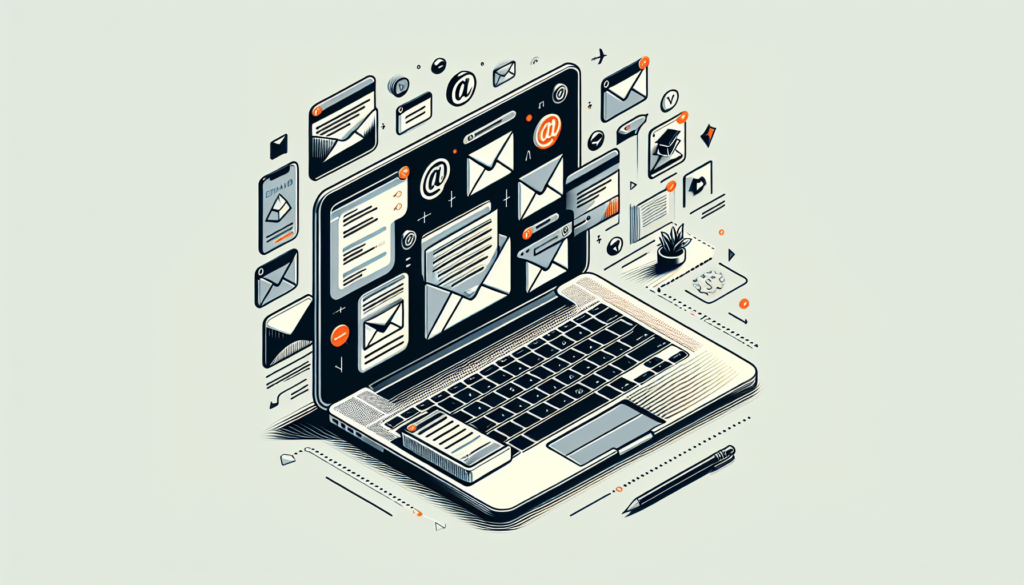In today’s digital age, email marketing has become an essential tool for e-commerce businesses to reach their target audience and increase sales. If you’re looking to take your e-commerce email marketing strategy to the next level, look no further. This article serves as the ultimate guide, providing you with proven techniques and tips to effectively engage your customers, boost conversions, and ultimately grow your business. Whether you’re a seasoned marketer or just starting out, these valuable insights will help you craft compelling email campaigns that resonate with your audience and drive results. So, let’s get started and unlock the potential of e-commerce email marketing!
1. Building a quality email list
Building a quality email list is essential for a successful email marketing campaign. By obtaining permission to send emails to individuals who are genuinely interested in your brand and products, you increase the chances of engagement and conversions. Here are some effective strategies to build a quality email list:
1.1 Using opt-in forms on your website
Opt-in forms are a powerful tool to capture email addresses from your website visitors. Placing opt-in forms strategically on your website, such as in the sidebar, footer, or as a pop-up, allows visitors to easily subscribe to your email list. Ensure that the opt-in forms are visually appealing and clearly communicate the value they will receive by subscribing to your emails.
1.2 Offering incentives to encourage sign-ups
People love incentives, and offering something valuable as a reward for signing up to your email list can significantly increase the number of subscribers. Consider offering discounts, free ebooks, exclusive content, or entry into a contest. These incentives not only motivate people to subscribe but also create a positive first impression of your brand.
1.3 Segmenting your email list for targeted marketing
Segmenting your email list allows you to send tailored content to specific groups of subscribers. By categorizing subscribers based on demographics, purchase history, or behavioral patterns, you can create personalized and relevant emails. This targeted approach improves engagement rates and increases the likelihood of conversions.
2. Creating compelling email content
Once you have built a quality email list, it’s crucial to focus on creating compelling content that grabs your subscribers’ attention and keeps them engaged. Here are some strategies to make your email content stand out:
2.1 Using personalized and dynamic content
Personalization is key to connecting with your subscribers on a deeper level. By addressing subscribers by their first names and using their previous purchase or browsing history, you can create a personalized experience that resonates with them. Dynamic content, such as recommendations based on their preferences or abandoned cart reminders, adds an extra level of relevance and increases the chances of conversion.
2.2 Writing attention-grabbing subject lines
Subject lines are the gateway to your emails, and they need to be compelling enough to entice subscribers to open them. Use attention-grabbing language, create a sense of urgency, and highlight the value or benefit subscribers will receive by opening your email. However, it’s important to avoid clickbait tactics and misleading subject lines, as they can harm your brand reputation.
2.3 Designing visually appealing emails
The aesthetics of your emails play a significant role in capturing and retaining subscribers’ attention. Use eye-catching images, clear and concise copy, and a well-organized layout. Ensure that your emails are mobile-friendly, as a growing number of people access their emails on smartphones and tablets. Additionally, make sure your emails align with your brand’s visual identity to maintain consistency and professionalism.

3. Automating email campaigns
Automating your email campaigns can save you time and effort while ensuring consistent communication with your subscribers. Here are some key automated email campaigns that can enhance your marketing strategy:
3.1 Setting up automated welcome emails
Welcome emails are the first point of contact with your subscribers and are a great opportunity to make a positive impression. Set up automated welcome emails that thank subscribers for joining your email list, provide relevant information about your brand, and offer exclusive discounts or incentives. These emails help build a strong relationship from the beginning and increase engagement.
3.2 Implementing cart abandonment emails
Cart abandonment is a common occurrence in e-commerce, but it doesn’t have to be the end of the customer journey. Implementing cart abandonment emails allows you to remind customers of the items they left behind and offer incentives to complete their purchase. By automating these emails, you can recover lost sales and improve conversion rates.
3.3 Triggering personalized product recommendations
Using customer data and browsing behavior, you can automatically trigger emails that recommend products relevant to each subscriber’s interests. By showcasing items they might be interested in based on their previous engagement, you can increase the chances of generating additional sales. Automated product recommendation emails create a personalized experience and make customers feel understood.
4. Optimizing email deliverability
Ensuring that your emails reach your subscribers’ inboxes is crucial for the success of your email marketing campaigns. Consider the following strategies to improve email deliverability:
4.1 Building a sender reputation
Building a positive sender reputation is essential to avoid being marked as spam by email service providers. Focus on sending relevant and engaging content, regularly clean your email list to remove inactive or unengaged subscribers, and monitor your email deliverability rates. An increased sender reputation improves the chances of your emails reaching the intended recipients’ inboxes.
4.2 Avoiding spam filters
To avoid your emails being flagged as spam, it’s important to follow best practices and avoid common triggers for spam filters. Some key factors include not using excessive capital letters or exclamation marks in your subject lines, avoiding deceptive subject lines or misleading content, and ensuring that your sending IP address is not associated with spam in any way.
4.3 Cleaning your email list regularly
Regularly cleaning your email list is crucial for maintaining a high-quality subscriber base. Remove inactive subscribers, as they can harm your email deliverability rates. Implement a process to verify and validate email addresses, reducing the number of undeliverable emails. By keeping your email list clean and up-to-date, you can maximize the effectiveness of your email marketing efforts.

5. Analyzing and testing email performance
To continuously improve your email marketing strategy, it’s important to analyze the performance of your campaigns and test different elements. Consider the following tactics:
5.1 Tracking email open and click-through rates
Tracking the open and click-through rates of your emails provides valuable insights into subscriber engagement. Analyze which subject lines, content, or offers generate the highest open and click-through rates, and use that data to inform future email campaigns. Pay attention to trends and patterns to identify what resonates with your audience.
5.2 A/B testing subject lines and CTAs
A/B testing, also known as split testing, allows you to compare the performance of different subject lines or calls-to-action (CTAs) within your emails. Create two variations of your subject line or CTA and send them to two different segments of your audience. Analyze the performance of each variation to identify which one generates better results. This iterative approach helps you optimize your email content for maximum impact.
5.3 Evaluating conversion rates and revenue generated
Ultimately, the success of your email marketing efforts can be measured by the conversion rates and revenue generated. Analyze the percentage of subscribers who take the desired action after receiving an email, such as making a purchase or signing up for a webinar. By tracking these metrics, you can identify opportunities to improve the effectiveness of your emails and drive more revenue for your business.
6. Personalization and segmentation strategies
Personalizing your email marketing campaigns based on customer data and segmenting your audience can significantly improve engagement and conversions. Consider the following strategies:
6.1 Using customer data to personalize emails
Leverage the data you have about your customers to create personalized emails. Use their first names, recommend products based on their purchase history, and tailor content to their preferences. By delivering relevant and personalized emails, you can strengthen the bond between your brand and your customers.
6.2 Segmenting your audience based on behavior and preferences
Segmenting your audience allows you to send targeted emails to specific groups of subscribers. Consider segmenting based on factors such as demographics, purchase history, engagement level, or preferences. By sending content that appeals directly to each segment, you can increase open and click-through rates, as well as conversions.
6.3 Implementing triggered emails based on customer actions
Triggered emails are automated emails that are sent based on specific customer actions or behaviors. Implementing these emails allows you to respond to customer actions in real-time and deliver relevant content. Examples of triggered emails include abandoned cart reminders, post-purchase follow-ups, or birthday greetings. These personalized and timely emails help nurture customer relationships and drive action.

7. Leveraging user-generated content
User-generated content (UGC) is a powerful tool for building trust and engaging your audience. Consider the following strategies to leverage UGC in your email marketing campaigns:
7.1 Encouraging customers to share reviews and testimonials
Ask your customers to leave reviews or testimonials about their experiences with your products or services. You can then showcase these reviews in your emails to provide social proof and build trust among your subscribers. Include quotes or snippets from positive reviews and link them to the full review on your website.
7.2 Curating user-generated content in emails
Collect and curate UGC, such as customer photos or videos featuring your products, and include them in your emails. Visual content created by your customers adds authenticity and helps potential customers envision themselves using your products. Feature UGC prominently in your emails to increase engagement and inspire trust.
7.3 Running contests or giveaways to generate content
Running contests or giveaways is an excellent way to encourage your audience to create and share content related to your brand or products. Ask participants to submit photos, videos, or testimonials to enter the contest, and use this UGC in your emails. This not only generates valuable content but also promotes engagement and fosters a sense of community.
8. Building trust and credibility
Building trust and credibility with your subscribers is crucial for a successful email marketing strategy. Consider the following tactics:
8.1 Using social proof in your emails
Include social proof elements in your emails, such as customer testimonials, reviews, or endorsements from influencers or experts in your industry. Social proof builds trust and validates the value of your products or services. Highlighting positive experiences and feedback from others can increase subscriber confidence in your brand.
8.2 Providing clear and transparent customer support
Make it easy for your subscribers to reach out to you for support or inquiries. Provide clear contact information, such as email addresses or phone numbers. Respond promptly to customer inquiries and resolve any issues they may have. By offering excellent customer support, you demonstrate your commitment to customer satisfaction.
8.3 Showcasing security measures and trust badges
Online security is a top concern for many consumers. To build trust, showcase the security measures you have in place to protect customer data, such as SSL certificates or secure payment gateways. Display trust badges or certifications from reputable organizations to further instill confidence in your subscribers.

9. Mobile optimization and responsive design
With more people accessing their emails on mobile devices, it’s crucial to optimize your emails for mobile viewing. Consider the following strategies:
9.1 Ensuring emails are mobile-friendly
Design your emails to be easily readable and visually appealing on smaller screens. Use a mobile-first approach by making your font sizes larger, using a single-column layout, and optimizing images for mobile devices. Test your emails on different mobile devices and email clients to ensure a seamless experience for your subscribers.
9.2 Optimizing for different email clients and devices
Email clients and devices can vary significantly in how they render emails. To ensure consistent rendering, test your emails on different clients and devices and make necessary adjustments. Pay attention to image scaling, button sizes, and overall email layout to guarantee a visually appealing experience for all your subscribers.
9.3 Using responsive design for a seamless user experience
Responsive design allows your emails to adapt dynamically to the screen size and orientation of the device on which they are viewed. By implementing responsive design techniques, your emails will maintain a consistent and user-friendly layout across various devices. This adaptability ensures that your subscribers can easily engage with your content, regardless of the device they are using.
10. Integrating email marketing with other channels
To maximize the impact of your email marketing efforts, consider integrating them with other channels. Here are a few strategies:
10.1 Combining email marketing with social media
Leverage the power of social media by including social sharing buttons in your emails. Encourage your subscribers to share your content with their networks, extending your reach and increasing the chances of acquiring new subscribers. Cross-promote your email content on social media platforms to drive engagement and nurture your audience.
10.2 Syncing email campaigns with your website
Align your email campaigns with your website by using consistent messaging, branding, and visuals. Include call-to-action buttons in your emails that direct subscribers to relevant landing pages on your website. By creating a seamless experience between your emails and website, you enhance the chances of driving conversions and retaining customers.
10.3 Using personalized retargeting across channels
Implement personalized retargeting campaigns that reach your subscribers across various channels, such as social media or display advertising. By retargeting individuals who have shown interest in your emails, you reinforce your brand and keep your products or services top of mind. Consistent personalization and messaging across channels create a cohesive customer experience and enhance the effectiveness of your marketing efforts.
In conclusion, implementing these effective e-commerce email marketing techniques can greatly enhance your marketing strategy and drive engagement and conversions. Building a quality email list, creating compelling email content, automating campaigns, optimizing deliverability, analyzing performance, leveraging personalization and segmentation, utilizing user-generated content, building trust and credibility, ensuring mobile optimization, and integrating email marketing with other channels are all vital components to achieve success in the competitive e-commerce landscape. Embrace these strategies, continuously test and refine your approach, and watch your email marketing efforts thrive.

